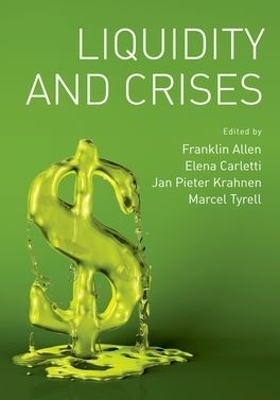
Liquidity and Crises
Oxford University Press Inc (Verlag)
978-0-19-539071-1 (ISBN)
Financial crises have been pervasive for many years. Their frequency in recent decades has been double that of the Bretton Woods Period (1945-1971) and the Gold Standard Era (1880-1993), comparable only to the period during the Great Depression. Nevertheless, the financial crisis that started in the summer of 2007 came as a great surprise to most people. What initially was seen as difficulties in the U.S. subprime mortgage market, rapidly escalated and spilled over first to financial markets and then to the real economy. The crisis changed the financial landscape worldwide and its full costs are yet to be evaluated.
One important reason for the global impact of the 2007-2009 financial crisis was massive illiquidity in combination with an extreme exposure of many financial institutions to liquidity needs and market conditions. As a consequence, many financial instruments could not be traded anymore, investors ran on a variety of financial institutions particularly in wholesale markets, financial institutions and industrial firms started to sell assets at fire sale prices to raise cash, and central banks all over the world injected huge amounts of liquidity into financial systems.
But what is liquidity and why is it so important for firms and financial institutions to command enough liquidity? This book brings together classic articles and recent contributions to this important field of research. It is divided into five parts. These are (i) liquidity and interbank markets; (ii) the public provision of liquidity and regulation; (iii) money, liquidity and asset prices; (iv) contagion effects; (v) financial crises and currency crises. The aim is to provide a comprehensive coverage of role of liquidity in financial crises.
Franklin Allen is the Nippon Life Professor of Finance and Professor of Economics at the Wharton School of the University of Pennsylvania. He has been on the faculty since 1980. He is currently Co-Director of the Wharton Financial Institutions Center. He is a past President of the American Finance Association. Elena Carletti is Professor of Economics at the European University Institute and Joint Chair of the Economics Department and Robert Schuman Center for Advanced Studies. Jan Pieter Krahnen is Chair of Corporate Finance at Johann Wolfgang Goethe-University Frankfurt. Marcel Tyrell is Professor of Entrepreneurship & Finance at Zeppelin University, Friedrichshafen
FRANKLIN ALLEN, ELENA CARLETTI, JAN PIETER KRAHNEN, AND MARCEL TYRELL; SECTION 1: LIQUIDITY AND INTERBANK MARKETS; SUDIPTO BHATTACHARYA/DOUGLAS GALE (LONDON SCHOOL OF ECONOMICS/NEW YORK UNIVERSITY); W. BARNETT AND K. SINGLETON, EDS., NEW APPROACHES TO MONETARY ECONOMICS, CAMBRIDGE UNIVERSITY PRESS, 1987, PP. 69-88; ANDREA EISFELDT (NORTHWESTERN UNIVERSITY); JOURNAL OF FINANCE, FEBRUARY 2004, 59, PP.1-30; FRANKLIN ALLEN/DOUGLAS GALE (THE WHARTON SCHOOL, UNIVERSITY OF PENNSYLVANIA/NEW YORK UNIVERSITY); ECONOMETRICA, 72(4), JULY 2004, PP. 1023-106.1; FRANKLIN ALLEN/DOUGLAS GALE (THE WHARTON SCHOOL, UNIVERSITY OF PENNSYLVANIA/NEW YORK UNIVERSITY); JOURNAL OF THE EUROPEAN ECONOMIC ASSOCIATION, 2(6), DECEMBER 2004, PP. 1015-1048; XAVIER FREIXAS/CORNELIA HOLTHAUSEN (UNIVERSITAT POMPEU FABRA, BARCELONA/EUROPEAN CENTRAL BANK, FRANKFURT); REVIEW OF FINANCIAL STUDIES, 18(2), SUMMER 2005, PP. 459-90; CRAIG FURFINE (FEDERAL RESERVE BANK OF CHICAGO); JOURNAL OF BUSINESS, JANUARY 2001, 74, 33-57; SECTION 2: PUBLIC PROVISION OF LIQUIDITY AND REGULATION; BENGT HOLMSTROM/JEAN TIROLE (MIT/ UNIVERSITE SCIENCES SOCIALES, TOULOUSE); JOURNAL OF POLITICAL ECONOMY, FEBRUARY 1998, 106, PP.1-40; GARY GORTON/LIXIN HUANG (THE WHARTON SCHOOL, UNIVERSITY OF PENNSYLVANIA/GEORGIA STATE UNIVERSITY); AMERICAN ECONOMIC REVIEW, 94(3), JUNE 2004, PP. 455-483; MARK FLANNERY (UNIVERSITY OF FLORIDA); JOURNAL OF MONEY, CREDIT AND BANKING, NOVEMBER 1996, 28(4), PP. 804-824; RAFAEL REPULLO (CEMFI); INTERNATIONAL JOURNAL OF CENTRAL BANKING, 1, DECEMBER 2005, PP. 47-80; JEAN-CHARLES ROCHET/XAVIER VIVES (UNIVERSITY SCIENCES SOCIALES, TOULOUSE/IESE, UNIVERSITY OF NAVARRA); JOURNAL OF THE EUROPEAN ECONOMIC ASSOCIATION, 2(6), DECEMBER 2004, PP. 1116-47; GIOVANNI DELL'ARICCIA/ROBERT MARQUEZ (IMF/ARIZONA STATE UNIVERSITY); JOURNAL OF FINANCIAL ECONOMICS, 79(2), FEBRUARY 2006, PP. 401-30; SECTION 3: MONEY, LIQUIDITY CRISES AND ASSET PRICES; DOUGLAS DIAMOND/RAGHURAM RAJAN (UNIVERSITY OF CHICAGO); AMERICAN ECONOMIC REVIEW, 96(1), MARCH 2006, PP. 30-53; NOBUHIRO KIYOTAKI/JOHN MOORE (PRINCETON UNIVERSITY/UNIVERSITY OF EDINBURGH); INTERNATIONAL ECONOMIC REVIEW, 46(2), MAY 2005, PP. 317-49; JUAN CORDOBA/MARLA RIPOLL (RICE UNIVERSITY/UNIVERSITY OF PITTSBURGH); JOURNAL OF THE EUROPEAN ECONOMIC ASSOCIATION, 2(6), DECEMBER 2004, PP. 1172-1205; GUIDO LORENZONI (MIT); REVIEW OF ECONOMIC STUDIES, 75(3), JULY 2008, PP. 809-833; SECTION 4: CONTAGION EFFECTS IN FINANCIAL CRISES; AMIL DASGUPTA (LONDON SCHOOL OF ECONOMICS AND POLITICAL SCIENCE); JOURNAL OF THE EUROPEAN ECONOMIC ASSOCIATION, 2(6), DECEMBER 2004, PP. 1049-84; VIRAL V. ACHARYA/TANJU YORULMAZER (LONDON BUSINESS SCHOOL/FEDERAL RESERVE BANK OF NEW YORK); JOURNAL OF MONEY, CREDIT AND BANKING, FEBRUARY 2008, 40(1), PP. 215-231; VIRAL V. ACHARYA/TANJU YORULMAZER (LONDON BUSINESS SCHOOL/FEDERAL RESERVE BANK OF NEW YORK); REVIEW OF FINANCIAL STUDIES, NOVEMBER 2008, 21, PP. 2705-2742; FRANKLIN ALLEN/ELENA CARLETTI (THE WHARTON SCHOOL, UNIVERSITY OF PENNSYLVANIA/ J.W. GOETHE-UNIVERSITAT FRANKFURT AND CFS); JOURNAL OF MONETARY ECONOMICS, 2008, 53, 89-111; CHRISTIAN UPPER/ANDREAS WORMS (BANK FOR INTERNATIONAL SETTLEMENTS/DEUTSCHE BUNDESBANK); EUROPEAN ECONOMIC REVIEW, 48(4), AUGUST 2004, PP. 827-49; SECTION 5: FINANCIAL CRISES AND CURRENCY CRISES; PHILIPP HARTMANN/STEFAN STRAETMANS/CASPER DE VRIES (EUROPEAN CENTRAL BANK/MAASTRICHT
| Erscheint lt. Verlag | 3.2.2011 |
|---|---|
| Zusatzinfo | 59 line drawings |
| Verlagsort | New York |
| Sprache | englisch |
| Maße | 249 x 178 mm |
| Gewicht | 1220 g |
| Themenwelt | Wirtschaft ► Betriebswirtschaft / Management ► Finanzierung |
| Wirtschaft ► Volkswirtschaftslehre ► Finanzwissenschaft | |
| ISBN-10 | 0-19-539071-7 / 0195390717 |
| ISBN-13 | 978-0-19-539071-1 / 9780195390711 |
| Zustand | Neuware |
| Haben Sie eine Frage zum Produkt? |
aus dem Bereich


